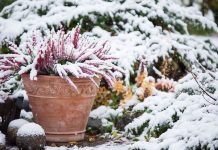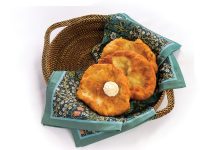When it comes to shapely shade-lovers, few plants overshadow the hosta as a favorite for Utah’s sun-dappled gardens. The tremendous variety of sizes, silhouettes, and lush tones of white, gold, blue, and green that this leafy plant offers has made it a favorite among gardeners whose cherished beds lie in the shadows of their yards.
Take a stroll along the north side of Red Butte Garden & Arboretum in Salt Lake City, and it’s easy to mistake the location for a remote forest rather than an urban botanical garden. Tall evergreens tower over a carpet of shaded ground covers, ferns, and, of course, thriving hostas. “Hostas generally do well here, evident by how often you see them in shady parts of people’s yards,” says Marita Tewes Tyrolt, horticulture director at Red Butte, as she stoops to finger the heart-shaped green and white leaves of a particularly large specimen. “Unfortunately, snails and slugs like them, too,” she adds.
Hostas’ proclivity for attracting garden pests aside, they are the ultimate perennials for shadowed beds. Grown primarily for their beautiful foliage, they come back year after year, survive bitter winters (to minus 40 degrees), make no special demands on the gardener’s time, and are widely available in nurseries and garden centers. Often referred to as plantain lilies, hostas promise a jolt of bold texture and eye-catching shapes to gardens.

While many gardeners encircle tree bases with thriving hostas, this plant also shows well when featured in a less traditional manner. Landscape designers suggest that rather than using hostas as the backdrop of a border, showcase a large specimen as a centerpiece of the shade garden, much like a statue. The deep green and yellow variegated leaves of the ‘Frances Williams’ (Hosta sieboldiana) make it a bold statement when surrounded by close-to-the-ground, shade-loving flowering annuals like phlox or Virginia bluebell. Alternatively, designers also propose planting a shorter, white and green variegated hosta like the ‘Francee’ (Hosta x ‘Francee’) within a bed filled with a variety of ground covers like the wispy foam flower, pink bleeding heart, variegated society garlic, and deep purple wine periwinkle. The result is a luxuriant tapestry of texture and color. Hostas also do well in containers and can create an almost architectural statement on a shaded patio or deck. The light green leaves of the ‘Honeybells’ (Hosta x plantaginea) produce interesting contrast when arranged in a pot with English ivy and pink or white impatiens.
However paired, hostas mix beautifully with companion plants that complement the host plants’ verdant leaves with bold color and texture. And in the spring, when hostas’ leaves are just beginning to emerge, flowering bulbs like daffodils, tulips, and crocus can fill the spare bed with character. As the hostas’ leaves grow larger, they successfully cover the bulbs’ spent flowers and foliage, providing a fresh look throughout the season and well into summer. During the summer months, hostas produce showy spikes of lily-like flowers in tones of white to lavender. Brilliantly colored begonias, impatiens, and other annuals can beautifully accent the hostas in a flourishing shade garden.

All varieties of hostas go dormant in the winter months, and because the leaves tend to get mushy if left intact through the winter, it’s best to cut them back and remove the dead foliage after the first hard frost of autumn. Hostas reach maturity in four to eight years, and left unchecked, larger hostas can grow up to two feet high and four feet in diameter, blocking sunlight to neighboring plants. Experts suggest dividing large and small hosta plants when no shoots sprout from the center of the mature specimens and their bare centers detract from their beauty.
The easiest time to divide hostas is in early spring, when new growth is visible but not too large to be damaged. To divide one, use a spade to dig all the way around the outside of the plant and lift the clump from the ground. Wash soil off the roots to expose the rhizomes. Using a sharp knife, cut through the clump, leaving at least three eyes or shoots and strong roots in each division. Replant divisions at the same depth as the original hole and pack soil tightly around the plant. Water both new and established hostas regularly throughout the summer months. Fresh new leaves will begin growing in the early spring. An annual dose of liquid fertilizer brings on an especially leafy show.

As for the slug problem, vigilant waterers and weeders can forgo mulch, which shades these pests and when omitted, helps keep them away. Other snail and slug repellants include crushed eggshells, fireplace ashes, and saucers filled with beer in which the slugs drown. Snail bait, used three to four times a year, also proves effective.
With the broad variety of hostas available, there are sure to be many cultivars perfect for any sun-challenged yard. Selection of the best sizes, colors, and shapes promises to bring shaded, high-style gardens out of the shadows.
Birds are great at keeping your hostas pest-free and thriving, learn how to make your yard flock-friendly here!






















